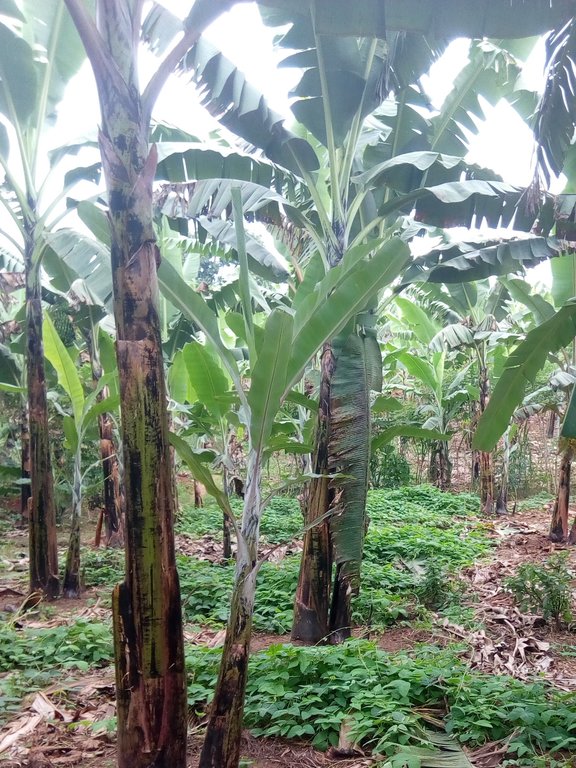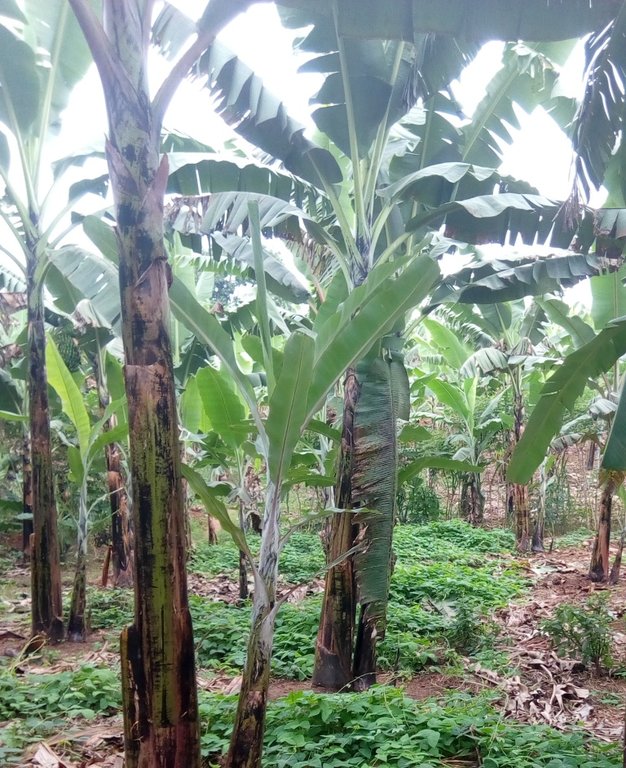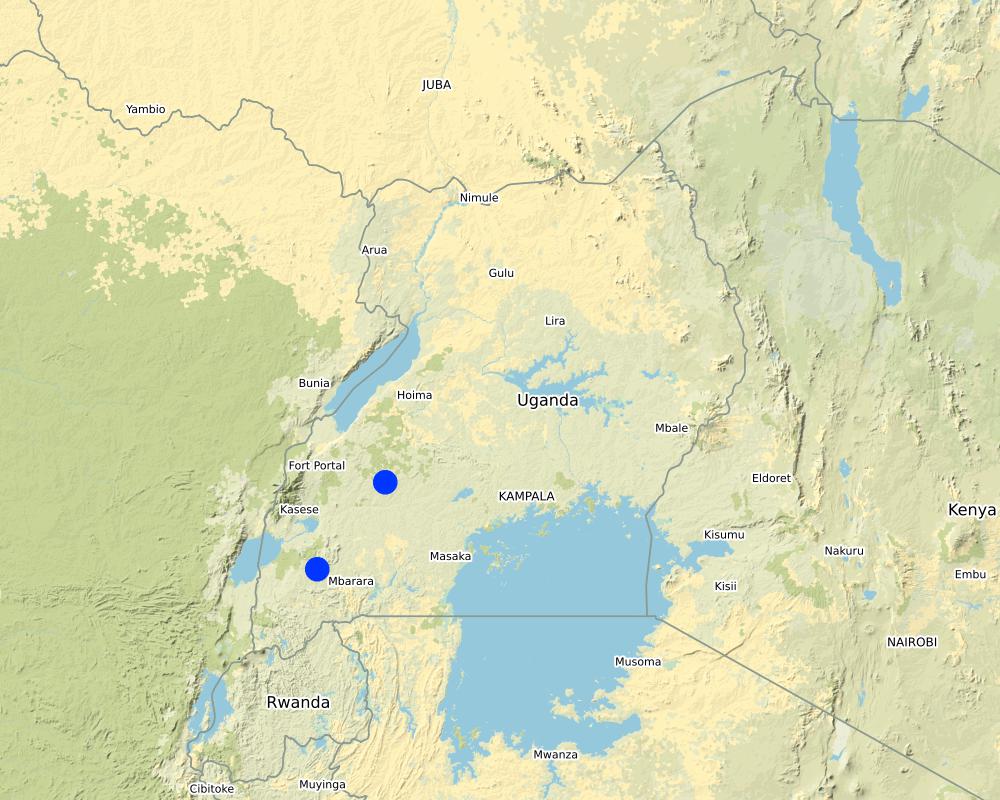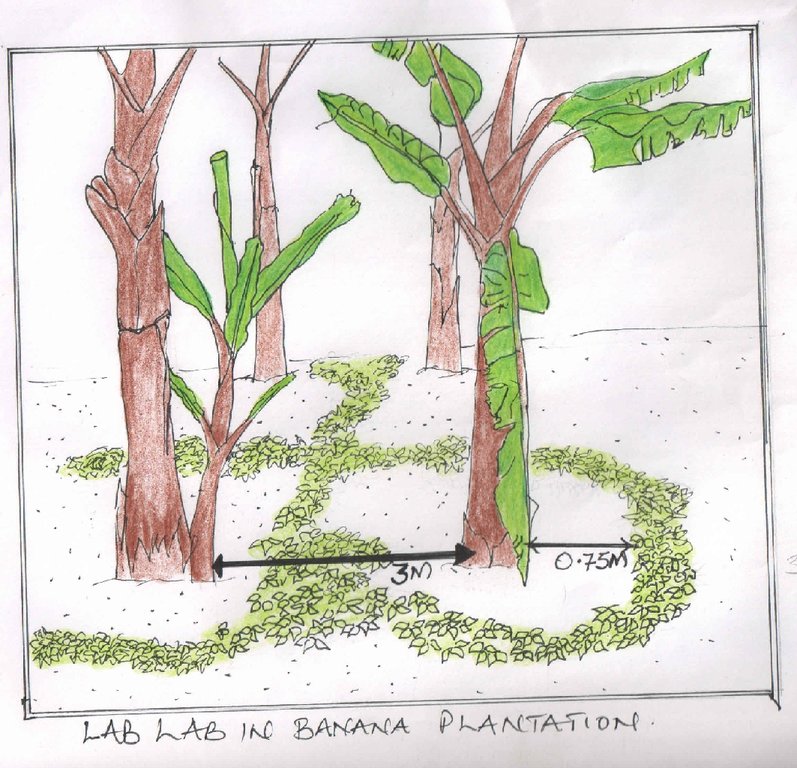Lab lab inter-crop for improvement of soil fertility for banana production [Uganda]
- Creation:
- Update:
- Compiler: Aine Amon
- Editor: Drake Mubiru
- Reviewers: Nicole Harari, Donia Mühlematter, Udo Höggel
Lablab Omurutokye
technologies_3376 - Uganda
View sections
Expand all Collapse all1. General information
1.2 Contact details of resource persons and institutions involved in the assessment and documentation of the Technology
Key resource person(s)
land user:
Kabasi Janet
+256784959305
Farmer
Fort portal Municipality, Kabarole District
Uganda
Name of project which facilitated the documentation/ evaluation of the Technology (if relevant)
Scaling-up SLM practices by smallholder farmers (IFAD)Name of the institution(s) which facilitated the documentation/ evaluation of the Technology (if relevant)
National Agricultural Research Organisation (NARO) - Uganda1.3 Conditions regarding the use of data documented through WOCAT
When were the data compiled (in the field)?
13/11/2017
The compiler and key resource person(s) accept the conditions regarding the use of data documented through WOCAT:
Ja
1.4 Declaration on sustainability of the described Technology
Is the Technology described here problematic with regard to land degradation, so that it cannot be declared a sustainable land management technology?
Nee
Comments:
The technology is a cover crop that adapts the ground to water scarcity and helps in nutrient replenishing
2. Description of the SLM Technology
2.1 Short description of the Technology
Definition of the Technology:
Lab lab (Lablab purpureus) is planted in a banana garden and trained to creep in the empty spaces for suppressing weeds, stabilizing the soil, fixing atmospheric nitrogen and controlling water runoff.
2.2 Detailed description of the Technology
Description:
The lab lab (Velvet), commonly called bataw or jarabilla, is widespread throughout the tropics. The legume is characterized by creeping and is normally planted as a cover crop in plantations where it is allowed to cover the open spaces. The leguminous crop is normally promoted and planted in banana gardens for it’s immense potential to control weeds and improve and conserve soil fertility. As an inter-crop, lab lab is usually combined with other crops for its high potential of fixing atmospheric nitrogen, controlling soil erosion, providing green manure and retaining soil moisture in support of the other crops. As a mono crop, lab lab is planted on bare land at all slope angles and at any scale to support the soil structure and to control run off. The leguminous plant is also known to be highly nutritious for livestock farming and is used to add protein content value to other pastures when making good quality fodder, silage and hay.
The lablab in the banana garden was established about 1.5 years ago; establishment of lablab legume in the banana garden is defined by the farmer to be simple and cheap depending on the size of land. The activities involved in establishing the cover crop include (1) weeding the garden to provide a competition free environment for the legume to grow. (2) Sowing of the seeds in the garden a few weeks to the start of the wet season (3) training of the germinating lablab at least 0.75 m away from the banana plants. The main maintenance activity involved is training the cover crops from invading the banana plants to avoid competition for nutrients.
The equipment required is only a hoe on small scale farms and maybe a tractor or curt on large scale farms. The expenses involved in the establishment process of lablab legume in a garden of 1.5 acres are mainly dependent on the availability of seed and labor. A kilogram of lablab seed was enough and costs the farmer $1.38, the labor to plough the banana plantation was provided by two of family members for 3 days valued at a total of $5.83. The profitability of the technology by the farmer where seen in the improvement in banana bunch size and the ever green banana plants maintained during the wet and dry season. The farmer before establishing lablab harvested banana bunches of sizes valued at US $ 2.78 – US $ 4.17 but today produces bigger bunches and sells at a price between US $ 4.17 – 5.56 on the local market. The average number of bunches harvested per month is also realized to have improved from 112 to 160 bunches. The weeds in the garden are no longer a big problem to the farmer and the soil moisture can be observed on the ground. The leaves of lablab also decompose as manure in addition to the known leguminous function of nitrogen fixation.
2.3 Photos of the Technology
2.4 Videos of the Technology
Date:
13/02/2018
Location:
Kabalore, Fort Portal Municipality, Njara Sub County
Name of videographer:
Mrs. Jalia Namakula
2.5 Country/ region/ locations where the Technology has been applied and which are covered by this assessment
Country:
Uganda
Region/ State/ Province:
Western Uganda, Kabarole District
Further specification of location:
Fort Portal Municipality, Njara Sub County
Map
×2.6 Date of implementation
Indicate year of implementation:
2016
2.7 Introduction of the Technology
Specify how the Technology was introduced:
- through projects/ external interventions
Comments (type of project, etc.):
The farmer learnt about the technology from another farmer in Bushenyi District South western Uganda.
3. Classification of the SLM Technology
3.1 Main purpose(s) of the Technology
- improve production
- reduce, prevent, restore land degradation
- reduce risk of disasters
- adapt to climate change/ extremes and its impacts
- create beneficial economic impact
3.2 Current land use type(s) where the Technology is applied

Cropland
- Perennial (non-woody) cropping
Main crops (cash and food crops):
Bananas
Comments:
The farmer also practices livestock farming including piggery and goat farming at a sustainable scale. The lab lab bean leaves are harvested during the dry season to supplement the livestock with leguminous feed.
If land use has changed due to the implementation of the Technology, indicate land use before implementation of the Technology:
The farmer previously inter-cropped bananas with beans and maize, the beans planted were for domestic food security. With the introduction of lab lab a perennial crop, the beans and maize are no longer part of the gardening system which has improved the quality and quantity of bananas harvested.
3.3 Further information about land use
Water supply for the land on which the Technology is applied:
- rainfed
Number of growing seasons per year:
- 2
Specify:
March - June and September - November
Livestock density (if relevant):
2 goats and 3 pigs kept on zero grazing at subsistence scale
3.4 SLM group to which the Technology belongs
- improved ground/ vegetation cover
- integrated soil fertility management
- ground water management
3.5 Spread of the Technology
Specify the spread of the Technology:
- evenly spread over an area
If the Technology is evenly spread over an area, indicate approximate area covered:
- < 0.1 km2 (10 ha)
Comments:
The farmer has 1.5 acres of land under lab lab bean and banana intercroping system
3.6 SLM measures comprising the Technology

vegetative measures
- V2: Grasses and perennial herbaceous plants
3.7 Main types of land degradation addressed by the Technology

soil erosion by water
- Wt: loss of topsoil/ surface erosion

soil erosion by wind
- Et: loss of topsoil

chemical soil deterioration
- Cn: fertility decline and reduced organic matter content (not caused by erosion)
3.8 Prevention, reduction, or restoration of land degradation
Specify the goal of the Technology with regard to land degradation:
- prevent land degradation
- adapt to land degradation
4. Technical specifications, implementation activities, inputs, and costs
4.1 Technical drawing of the Technology
4.2 Technical specifications/ explanations of technical drawing
The banana plantains are spaced 3 x 3 m between plants. The lab lab (Velvet) bean is planted and trained to creep in the open spaces, 0.75m away from the base of the banana.
4.3 General information regarding the calculation of inputs and costs
Specify how costs and inputs were calculated:
- per Technology area
Indicate size and area unit:
Acre
If using a local area unit, indicate conversion factor to one hectare:
2.5
other/ national currency (specify):
Uganda Shilling
Indicate exchange rate from USD to local currency (if relevant): 1 USD =:
3600.0
Indicate average wage cost of hired labour per day:
3500
4.4 Establishment activities
| Activity | Type of measure | Timing | |
|---|---|---|---|
| 1. | weeding the plantation | Management | A month to the rain season |
| 2. | Seeding | Agronomic | Three weeks to the rain season |
| 3. | Training the creeping direction of the legume | Management | A month in the rain season |
Comments:
Most of the establishment and maintenance activities are done by the family members
4.5 Costs and inputs needed for establishment
| Specify input | Unit | Quantity | Costs per Unit | Total costs per input | % of costs borne by land users | |
|---|---|---|---|---|---|---|
| Labour | Labor for 3days | Man days | 6.0 | 6000.0 | 36000.0 | 100.0 |
| Equipment | Hire a hoe | Pieces | 2.0 | 1000.0 | 2000.0 | 100.0 |
| Plant material | Lablab bean seeds | Kilo grams | 1.0 | 5000.0 | 5000.0 | 100.0 |
| Total costs for establishment of the Technology | 43000.0 | |||||
Comments:
The technology is cheap relative to the farmer's economic capacity
4.6 Maintenance/ recurrent activities
| Activity | Type of measure | Timing/ frequency | |
|---|---|---|---|
| 1. | Training the creeping lab lab bean | Management | A month in the rainy season |
| 2. | Harvesting the fodder for pigs and goats | Management | Two months after the planting |
Comments:
Most of the maintenance activities are simple and labor is provided by the farmer's family
4.7 Costs and inputs needed for maintenance/ recurrent activities (per year)
| Specify input | Unit | Quantity | Costs per Unit | Total costs per input | % of costs borne by land users | |
|---|---|---|---|---|---|---|
| Labour | Training of creeping lab lab beans twice a year | mandays | 2.0 | 6000.0 | 12000.0 | 100.0 |
| Labour | Harvesting the ready lab lab for goats and pig fodder | Manhours | 30.0 | 1000.0 | 30000.0 | 100.0 |
| Total costs for maintenance of the Technology | 42000.0 | |||||
Comments:
These activities are simple and the labor was provided by the farmer
4.8 Most important factors affecting the costs
Describe the most determinate factors affecting the costs:
The availability of lablab bean seeds for planting and the availability of labor required for preparing the garden
5. Natural and human environment
5.1 Climate
Annual rainfall
- < 250 mm
- 251-500 mm
- 501-750 mm
- 751-1,000 mm
- 1,001-1,500 mm
- 1,501-2,000 mm
- 2,001-3,000 mm
- 3,001-4,000 mm
- > 4,000 mm
Agro-climatic zone
- humid
5.2 Topography
Slopes on average:
- flat (0-2%)
- gentle (3-5%)
- moderate (6-10%)
- rolling (11-15%)
- hilly (16-30%)
- steep (31-60%)
- very steep (>60%)
Landforms:
- plateau/plains
- ridges
- mountain slopes
- hill slopes
- footslopes
- valley floors
Altitudinal zone:
- 0-100 m a.s.l.
- 101-500 m a.s.l.
- 501-1,000 m a.s.l.
- 1,001-1,500 m a.s.l.
- 1,501-2,000 m a.s.l.
- 2,001-2,500 m a.s.l.
- 2,501-3,000 m a.s.l.
- 3,001-4,000 m a.s.l.
- > 4,000 m a.s.l.
Indicate if the Technology is specifically applied in:
- not relevant
5.3 Soils
Soil depth on average:
- very shallow (0-20 cm)
- shallow (21-50 cm)
- moderately deep (51-80 cm)
- deep (81-120 cm)
- very deep (> 120 cm)
Soil texture (topsoil):
- medium (loamy, silty)
Soil texture (> 20 cm below surface):
- medium (loamy, silty)
Topsoil organic matter:
- medium (1-3%)
5.4 Water availability and quality
Ground water table:
5-50 m
Availability of surface water:
medium
Water quality (untreated):
for agricultural use only (irrigation)
Is water salinity a problem?
Nee
Is flooding of the area occurring?
Nee
Comments and further specifications on water quality and quantity:
The water used for domestic use is mainly tap water and rooftop harvested water
5.5 Biodiversity
Species diversity:
- medium
Habitat diversity:
- medium
5.6 Characteristics of land users applying the Technology
Sedentary or nomadic:
- Sedentary
Market orientation of production system:
- subsistence (self-supply)
Off-farm income:
- > 50% of all income
Relative level of wealth:
- average
Individuals or groups:
- individual/ household
Level of mechanization:
- manual work
Gender:
- women
- men
Age of land users:
- middle-aged
Indicate other relevant characteristics of the land users:
The landuser belongs to the community elite as he/she working as a teacher in a secondary school.
5.7 Average area of land owned or leased by land users applying the Technology
- < 0.5 ha
- 0.5-1 ha
- 1-2 ha
- 2-5 ha
- 5-15 ha
- 15-50 ha
- 50-100 ha
- 100-500 ha
- 500-1,000 ha
- 1,000-10,000 ha
- > 10,000 ha
Is this considered small-, medium- or large-scale (referring to local context)?
- small-scale
5.8 Land ownership, land use rights, and water use rights
Land ownership:
- individual, not titled
Land use rights:
- individual
Water use rights:
- communal (organized)
- individual
5.9 Access to services and infrastructure
health:
- poor
- moderate
- good
education:
- poor
- moderate
- good
technical assistance:
- poor
- moderate
- good
employment (e.g. off-farm):
- poor
- moderate
- good
markets:
- poor
- moderate
- good
energy:
- poor
- moderate
- good
roads and transport:
- poor
- moderate
- good
drinking water and sanitation:
- poor
- moderate
- good
financial services:
- poor
- moderate
- good
6. Impacts and concluding statements
6.1 On-site impacts the Technology has shown
Socio-economic impacts
Production
crop production
Quantity before SLM:
50
Quantity after SLM:
65
crop quality
Comments/ specify:
Bigger bunches of matooke at all times of the year.
fodder production
Comments/ specify:
More leave-material for feeding goats and pigs is available.
risk of production failure
Comments/ specify:
The dry season normally retards banana production. However, this is now minimized through the moisture retention capacity of lab lab.
Income and costs
expenses on agricultural inputs
Comments/ specify:
Weeding expenses no longer incurred.
Ecological impacts
Water cycle/ runoff
surface runoff
Comments/ specify:
Lab lab is a cover crop and contributes to reducing the rainwater run-off.
Soil
soil moisture
soil cover
soil loss
soil crusting/ sealing
soil compaction
nutrient cycling/ recharge
soil organic matter/ below ground C
Biodiversity: vegetation, animals
Vegetation cover
biomass/ above ground C
Climate and disaster risk reduction
flood impacts
drought impacts
6.2 Off-site impacts the Technology has shown
water availability
impact of greenhouse gases
6.3 Exposure and sensitivity of the Technology to gradual climate change and climate-related extremes/ disasters (as perceived by land users)
Gradual climate change
Gradual climate change
| Season | Type of climatic change/ extreme | How does the Technology cope with it? | |
|---|---|---|---|
| annual temperature | increase | moderately | |
| seasonal temperature | dry season | increase | very well |
| annual rainfall | decrease | well | |
| seasonal rainfall | wet/ rainy season | increase | well |
Climate-related extremes (disasters)
Meteorological disasters
| How does the Technology cope with it? | |
|---|---|
| local rainstorm | very well |
Climatological disasters
| How does the Technology cope with it? | |
|---|---|
| drought | very well |
6.4 Cost-benefit analysis
How do the benefits compare with the establishment costs (from land users’ perspective)?
Short-term returns:
positive
Long-term returns:
positive
How do the benefits compare with the maintenance/ recurrent costs (from land users' perspective)?
Short-term returns:
slightly positive
Long-term returns:
slightly positive
6.5 Adoption of the Technology
- single cases/ experimental
6.6 Adaptation
Has the Technology been modified recently to adapt to changing conditions?
Nee
6.7 Strengths/ advantages/ opportunities of the Technology
| Strengths/ advantages/ opportunities in the land user’s view |
|---|
| Manure from falling leaves |
| Suppresses weeds |
| Feed for animals |
| Strengths/ advantages/ opportunities in the compiler’s or other key resource person’s view |
|---|
| Improves moisture retention in the soil |
| Reduces run off |
| Nitrogen fixation into the soil |
| Establishment is cheap and needs simple tools like hoes |
6.8 Weaknesses/ disadvantages/ risks of the Technology and ways of overcoming them
| Weaknesses/ disadvantages/ risks in the land user’s view | How can they be overcome? |
|---|---|
| The cover crop is invasive and doesn't favor inter cropping |
| Weaknesses/ disadvantages/ risks in the compiler’s or other key resource person’s view | How can they be overcome? |
|---|---|
| The foliage may be a habitat to vermins like snakes and rats | Setting traps in case of infestation |
7. References and links
7.1 Methods/ sources of information
- field visits, field surveys
Two farmers
- interviews with land users
1
7.3 Links to relevant information which is available online
Title/ description:
LABLAB Lablab purpureus (L.) Sweet
URL:
https://plants.usda.gov/plantguide/pdf/pg_lapu6.pdf
Links and modules
Expand all Collapse allLinks
No links
Modules
No modules






